Manchester City and Tottenham Hotspur: two teams that filled our social media timelines every single day over the last week and a half. They played each other three times in a 10-day span. The first two were in the quarter-final of the Champions League; the last was matchday 34 of the Premier League.
In the first meeting of the 10-day trilogy, Pep Guardiola’s cautious approach failed to unlock Spurs’ defence at the brand-new Tottenham Hotspur Stadium. On top of that, Sergio Agüero’s missed penalty in the first half gave more misery as City couldn’t get any away-goal advantage. Mauricio Pochettino’s Spurs then took a precious 1–0 win via Son Heung-min’s strike late in the second half.
A week later, both teams went into a dramatic shootout. Four goals were scored just inside the opening 11 minutes. Drama unfolded in the last quarter hour of the game, with VAR the main star in the process. Fernando Llorente’s controversial equaliser and Raheem Sterling’s disallowed last-minute winner, both decisions given with VAR’s help, sent the teams into contrasting moods. Spurs then reached their first Champions League semi-final since 1962 thanks to the away-goal rule.
As fatigue and injuries hit both City and Spurs, they came into the Saturday’s match with depleted squads. City desperately needed a win to keep their title hope alive. Meanwhile Spurs were craving a victory so they could clinch a top-four spot as soon as possible. It was Guardiola’s City that came out victorious through Phil Foden’s first-ever league goal. This tactical analysis will break down how the match unfolded.
Lineups
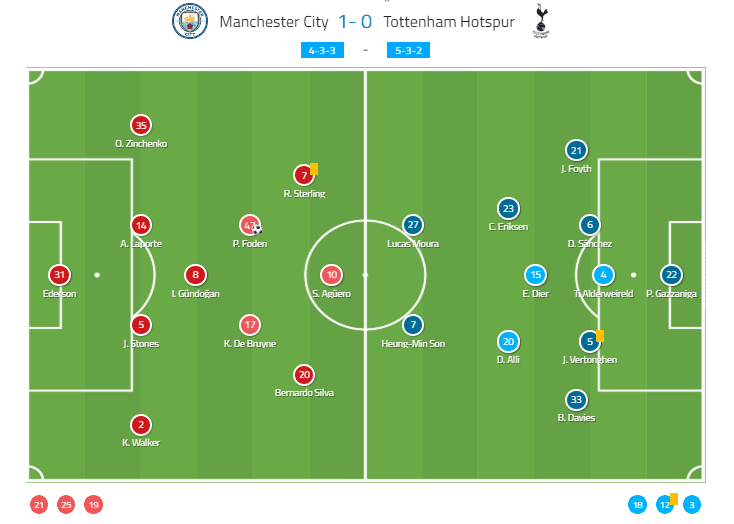
Guardiola chose his preferred 4–3–3 in this match. Oleksandr Zinchenko and John Stones returned to the defence to play alongside Aymeric Laporte and Kyle Walker. In the engine room, 18-year-old Foden was chosen to start alongside Kevin De Bruyne and ex-Dortmund midfielder İlkay Gündoğan. Up front, there were Bernardo Silva, Agüero, and Sterling. City’s bench was filled with names like Leroy Sané, Gabriel Jesus, and Riyad Mahrez.
Meanwhile, Pochettino opted for a more defensive approach as his team played in 5–3–2. Juan Foyth and Davinson Sanchez were among the back five, next to Toby Alderweireld, Jan Vertonghen, and Ben Davies. Spurs’ midfield line consisted of former Ajax man Christian Eriksen, Dele Alli, and Eric Dier. As Harry Kane is out due to injury, ex-PSG player Lucas Moura was again given the chance to start alongside on-fire Son. In the dugout, there were Victor Wanyama, Danny Rose, and former Juventus striker Llorente.
Anatomy of a goal (part one): City punish Spurs’ poor spacing
Previously in this trilogy, Foden was only an unused sub in the first leg of the Champions League quarter-final. Guardiola’s massive gamble to start him in such an important match proved worthwhile; the young midfielder scored his first-ever league goal just five minutes into the game.
The goal started with City’s left-side focused attack. An overload on City’s left-hand side forced Spurs’ entire midfield line to focus on that area. With only three men in their midfield, they abandoned the ball-far side. In theory, Vertonghen or Davies could have provided cover in that vacated area with aggressive defending. However, the two defenders weren’t able to do that. Davies was pinned by Bernardo on the right flank, while Vertonghen had to focus on De Bruyne in the right-side half-space.
Gündoğan then found Walker free in that half-space. Walker exploited a huge gap in front of him by carrying the ball into the final third with a driving run. That happened because both De Bruyne and Bernardo pinned their respective markers, as mentioned above.
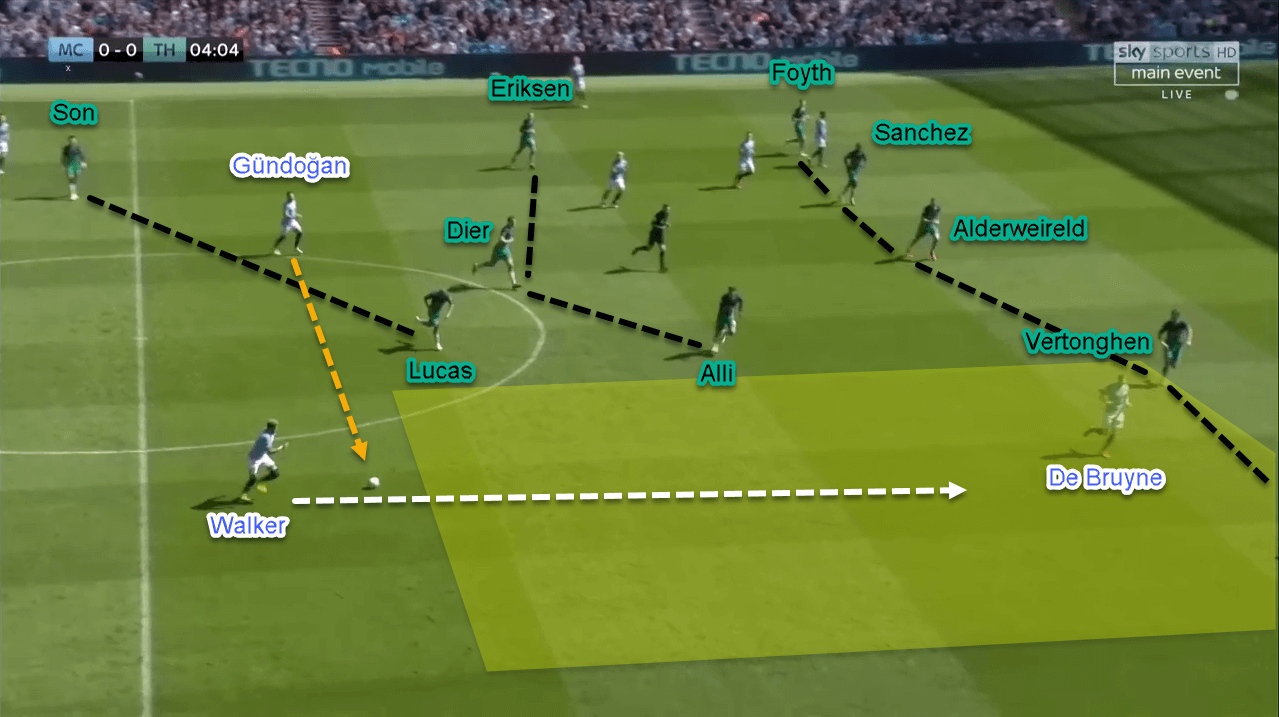
De Bruyne then smartly moved more inside and pinned Vertonghen even deeper by doing so. Alli then came to help and supported Vertonghen by shadow-covering De Bruyne. Actually, De Bruyne never wanted the ball. His inside movement was intended to open a passing lane into Bernardo. Walker then gave the ball to the former Monaco winger, who now got into a one-on-one situation against Davies.
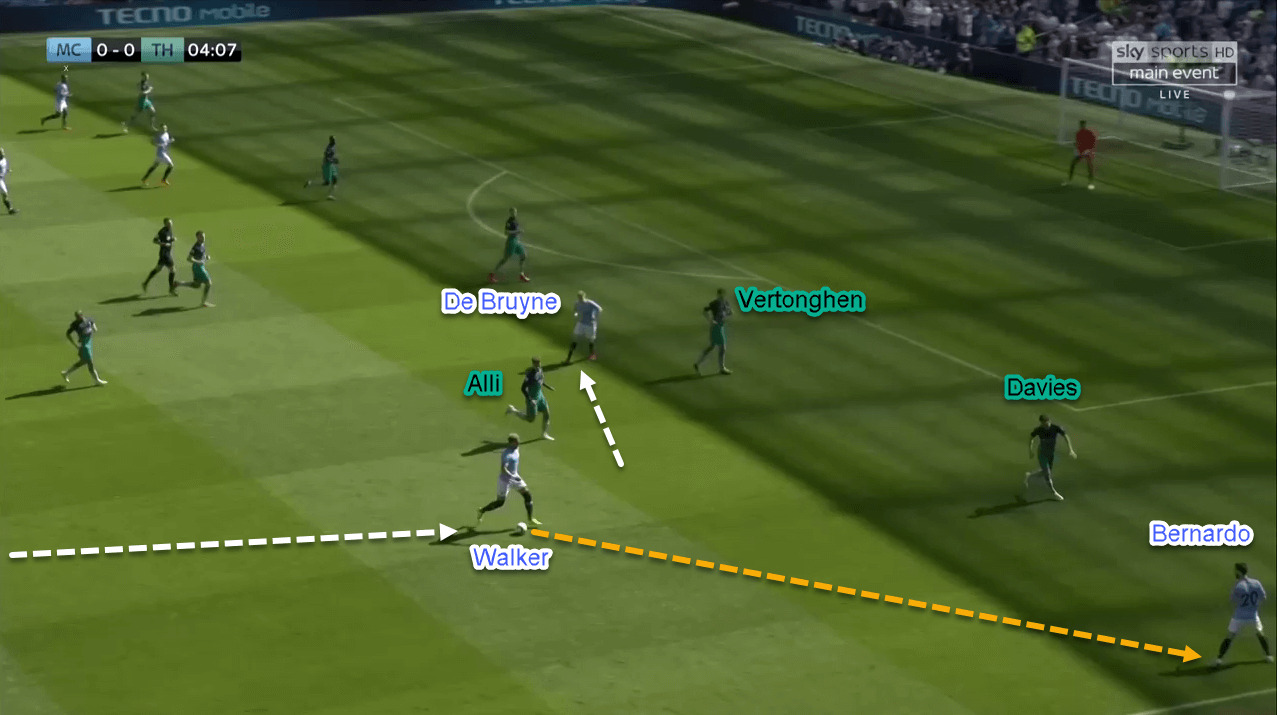
Anatomy of a goal (part two): Telepathic teamwork
Shortly after giving the ball to Bernardo, Walker continued his run – now without the ball – behind Spurs’ defensive line. Walker’s run opened two possibilities for Bernardo: make a through-ball to the right-back, or make an inside dribble movement by himself. The Portuguese winger chose the latter, as he realised Alli had followed Walker and gave up space by doing that.
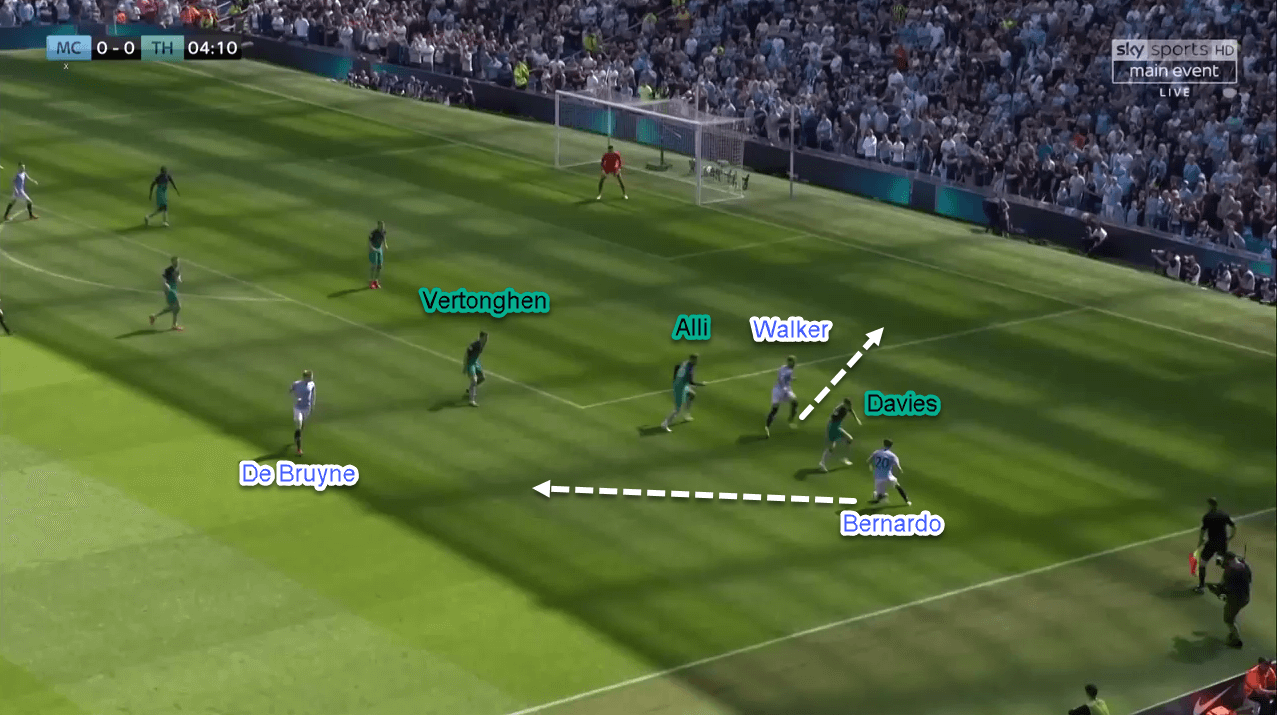
Knowing that Bernardo would move inside, De Bruyne started to drift wide. Again, Vertonghen followed his compatriot closely. De Bruyne then drifted wider, freed himself from the centre-back, and even positioned himself on the right flank. He did this in case Bernardo found a roadblock and needed support. By positioning himself in that area, De Bruyne was placed in a good zone to deliver one of his signature in-swinging crosses if needed.
Bernardo had another idea. He carried the ball into the right half-space even further. Recognising the threat, Vertonghen switched his focus to the Portuguese. Knowing Walker was no longer an option in this attacking scenario, Alli and Davies came up to support the centre-back. After confusing three opponents with his dribble, Bernardo found a yard of space and crossed the ball into the box.
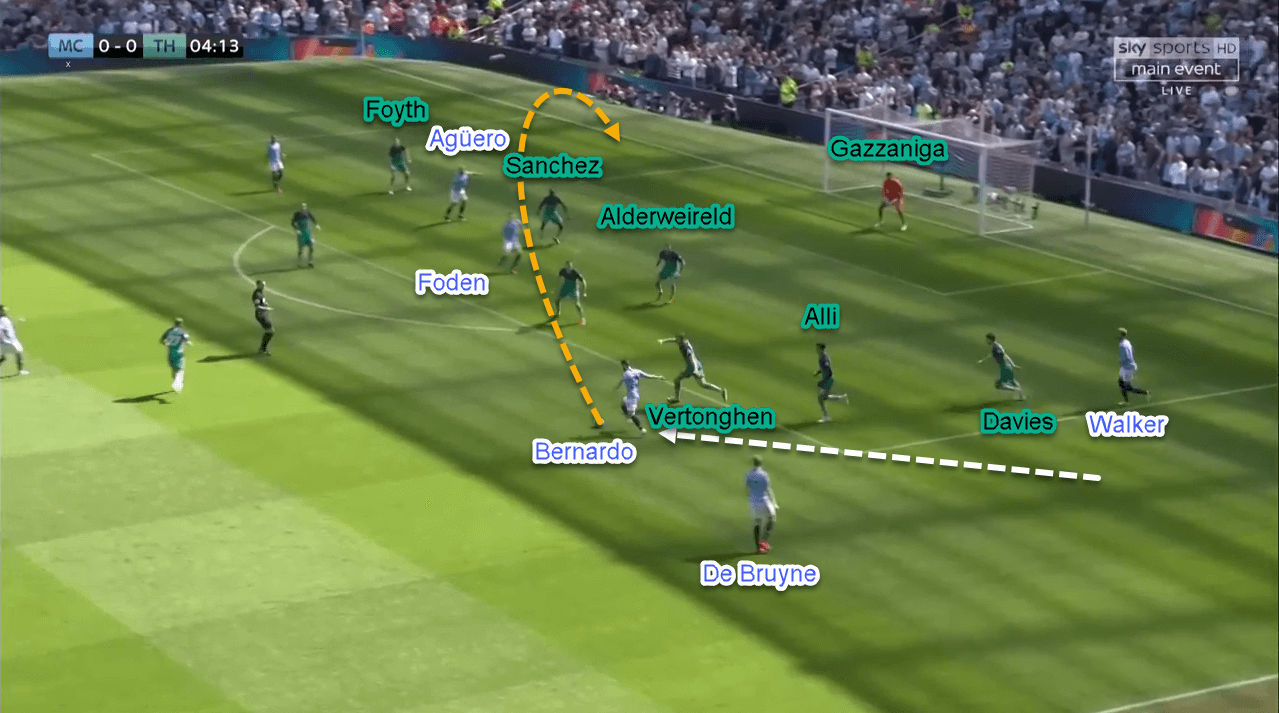
Anatomy of a goal (part three): Unselfish Agüero serves Foden
In the image above we can see that City’s targets are Agüero and Foden. Bernardo then sends the ball in to City’s captain, who was waiting at the far post. Bernardo opted for Agüero since the Argentinian was situated in Sánchez’s blind-spot, giving the striker a positional advantage. Foden then smartly moved towards the near post, confusing Sánchez even more.
Agüero then received Bernardo’s pinpoint cross with no pressure at all at the far post. Questions must be asked of Foyth, who either didn’t realise this would happen or was too lazy to help Sánchez. Agüero, who could have scored with his header, chose to square the ball into Foden’s path. Alderweireld realised the threat in Foden but the defender was too late to react. The youngster then nodded the ball in to give City their much-needed goal. Advantage City.
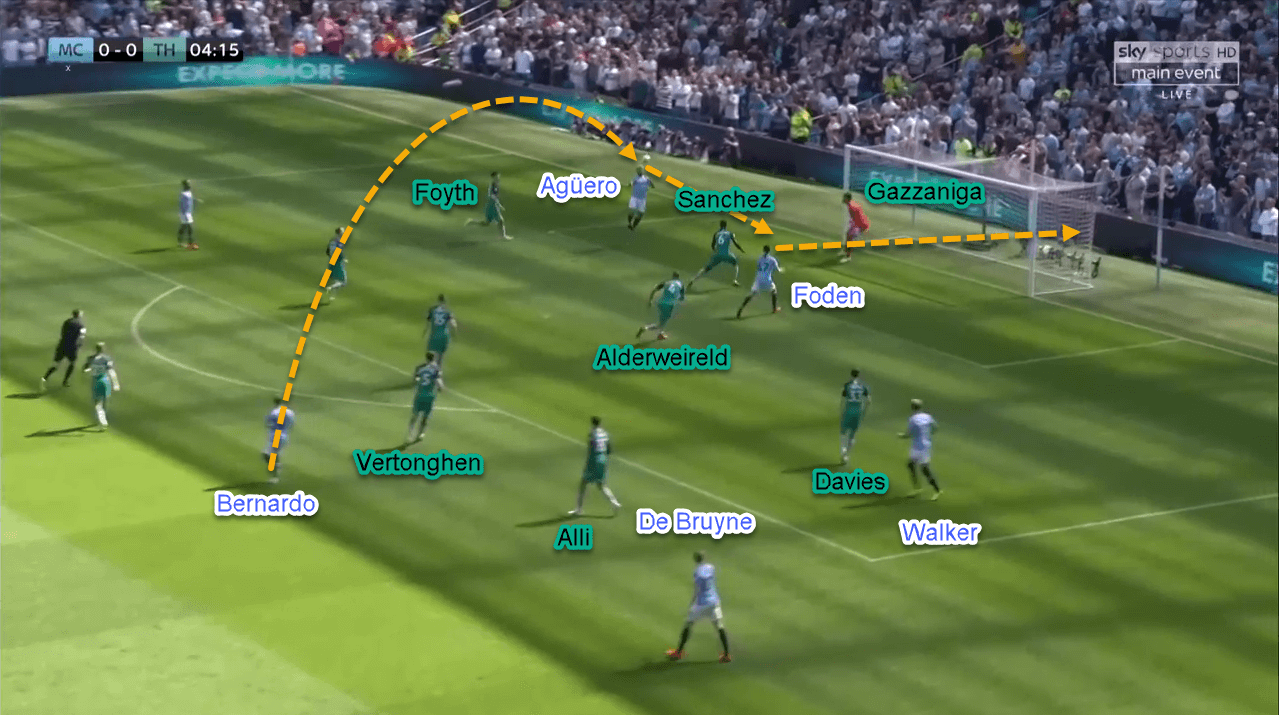
City try to exploit the space behind Sánchez
As mentioned previously, Spurs used 5–3–2 when they didn’t have the ball. The 5–3–2 deployed was quite compact in order to prevent City from playing between the lines. If City tried to play in between the lines, then Spurs’ ball-side centre-back (mainly Sánchez, as City focused their attack on their left-hand side) would follow the receiver and force him to play backwards passes.
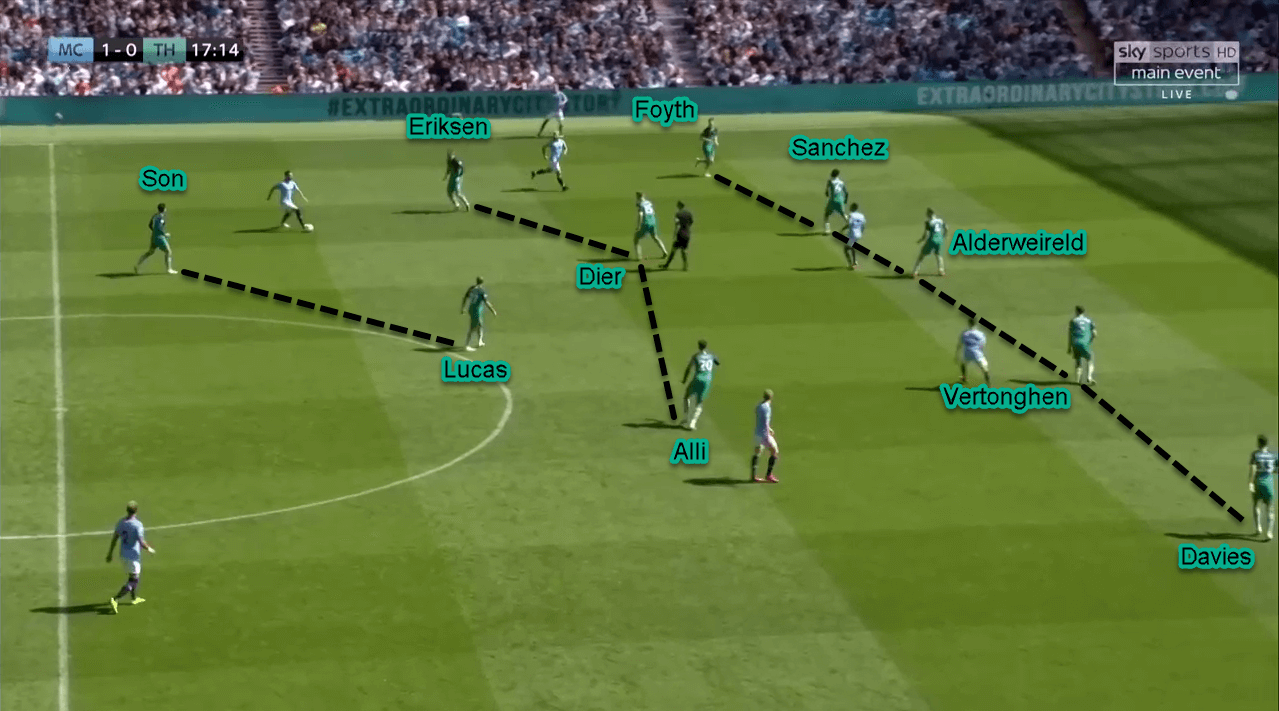
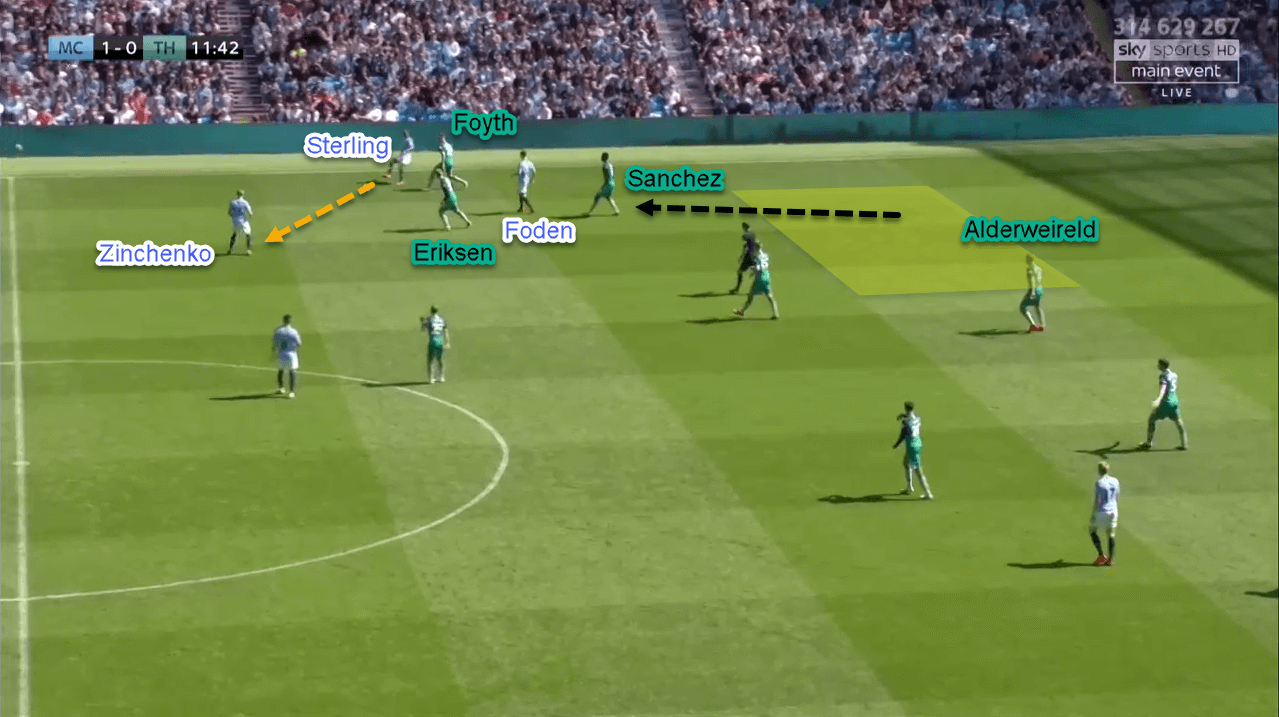
However, Guardiola found a way to counter this. He instructed his team to play more centrally, creating in the half-space rather than on the left flank. By moving centrally and overloading the half-space, combinations were easier to make. Furthermore, Sterling and Agüero often switched positions before combining, making it harder for the defenders to track them.
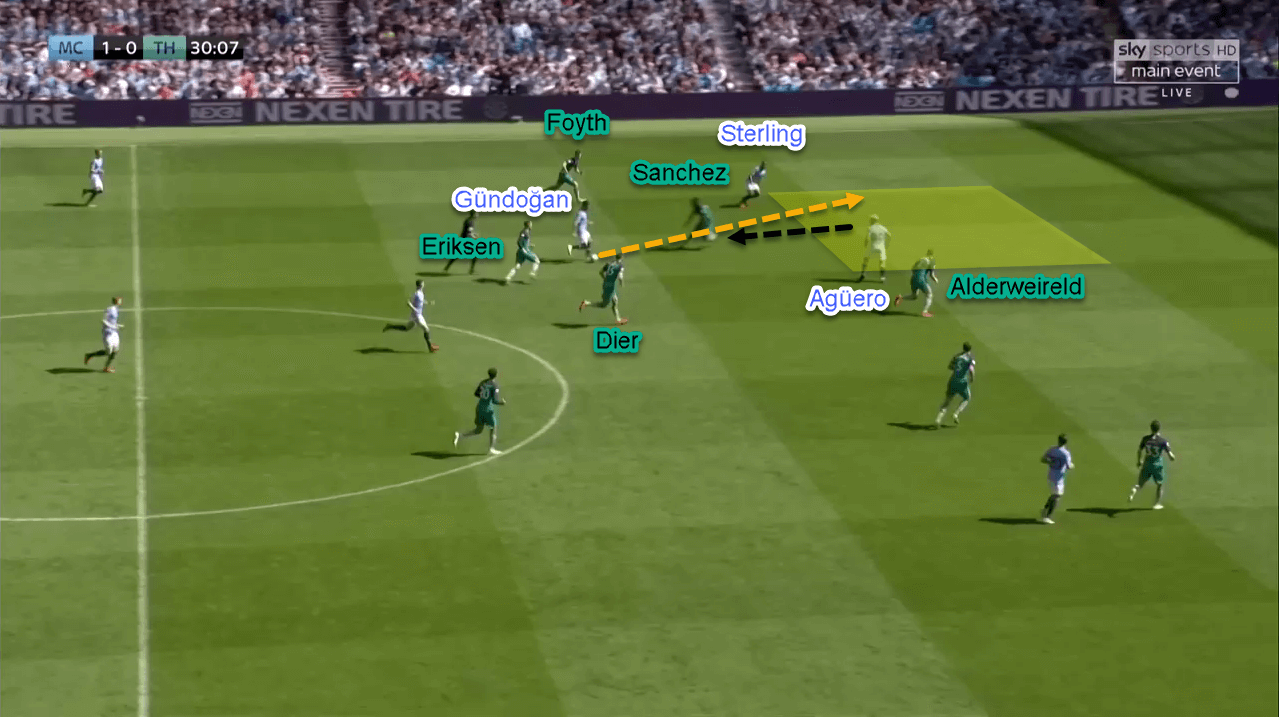
Not only by short combinations to find Sterling or Agüero in behind, but City also had another option to attack that space. One alternative was via Laporte’s lofted through-balls. With this pass below, Laporte tries to find Zinchenko, who has already started his run from Foyth’s blind-spot on the left flank.
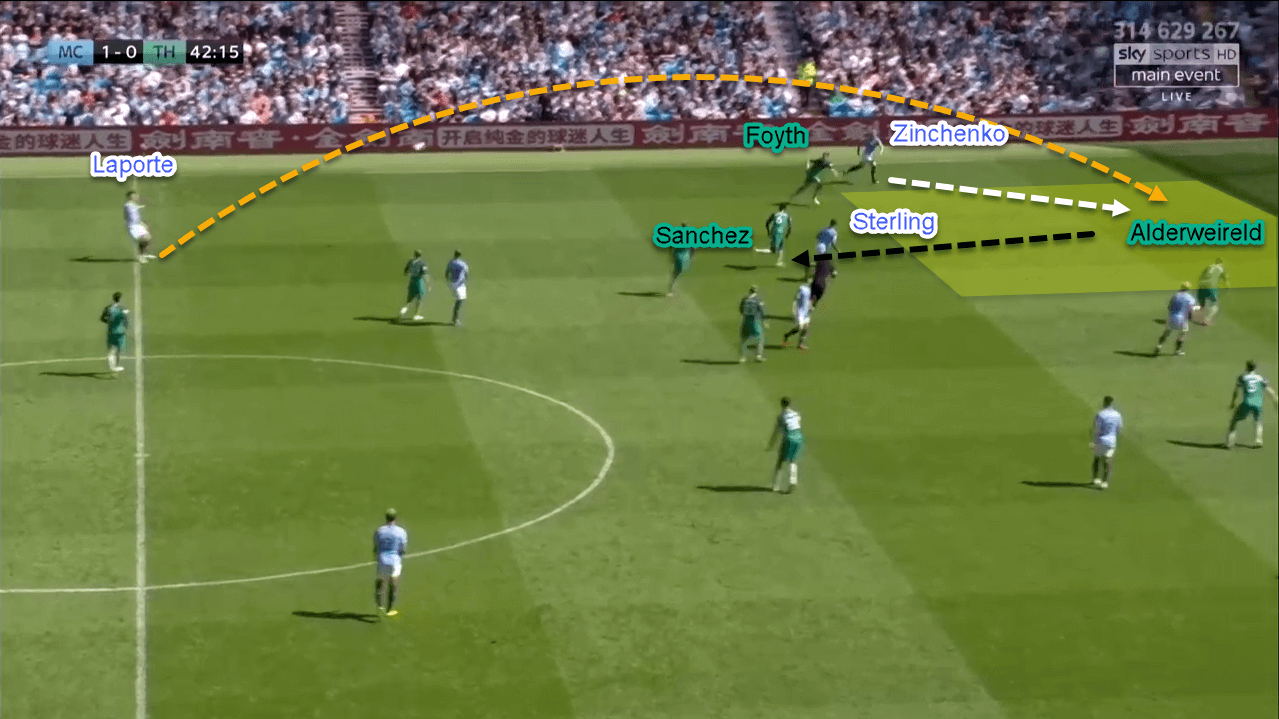
Although City were able to locate Spurs’ weakness in such a particular area, they were not able to capitalise on it. Their executions were never perfect, to be fair. Even if they could find their target in behind, Foyth or Alderweireld would cover quite quickly and prevent further threats.
City’s alternative left-hand side build-up
Guardiola made another variation in how his team progressed the ball into Spurs’ half. He did that by giving his full-backs different tasks. Walker was instructed to move inside and position himself in the right-side half-space. By doing that, Walker moved next to the centre-backs to form a temporary back three with Stones and Laporte. Both of them shifted due to Walker’s positioning, with Stones moving centrally and Laporte moving into the left-side half-space.
Meanwhile, Zinchenko was given a totally different task. In the image above we can see how Zinchenko was situated on the left flank. In that area, he provided the width for City if Sterling was tucked inside. Sometimes Zinchenko also provided overlapping runs beyond Spurs’ right wing-back.
One interesting way Guardiola used Zinchenko was to tuck him inside next to Gündoğan. This would form a 3–2–5/3–2–4–1 shape with him as a temporary midfielder. When Zinchenko moved inside, he pulled Eriksen with him. This was the objective because by pulling Eriksen inside, it opened a clear space for Laporte.
When Laporte had space in front of him, he could make driving runs just like Walker did, even though he wasn’t as good as his English teammate in that aspect. Laporte alternated by finding Sterling on the left flank. This allowed Sterling to face Foyth in a one-on-one situation. City used this particular approach if passing lanes into Gündoğan or De Bruyne were blocked.
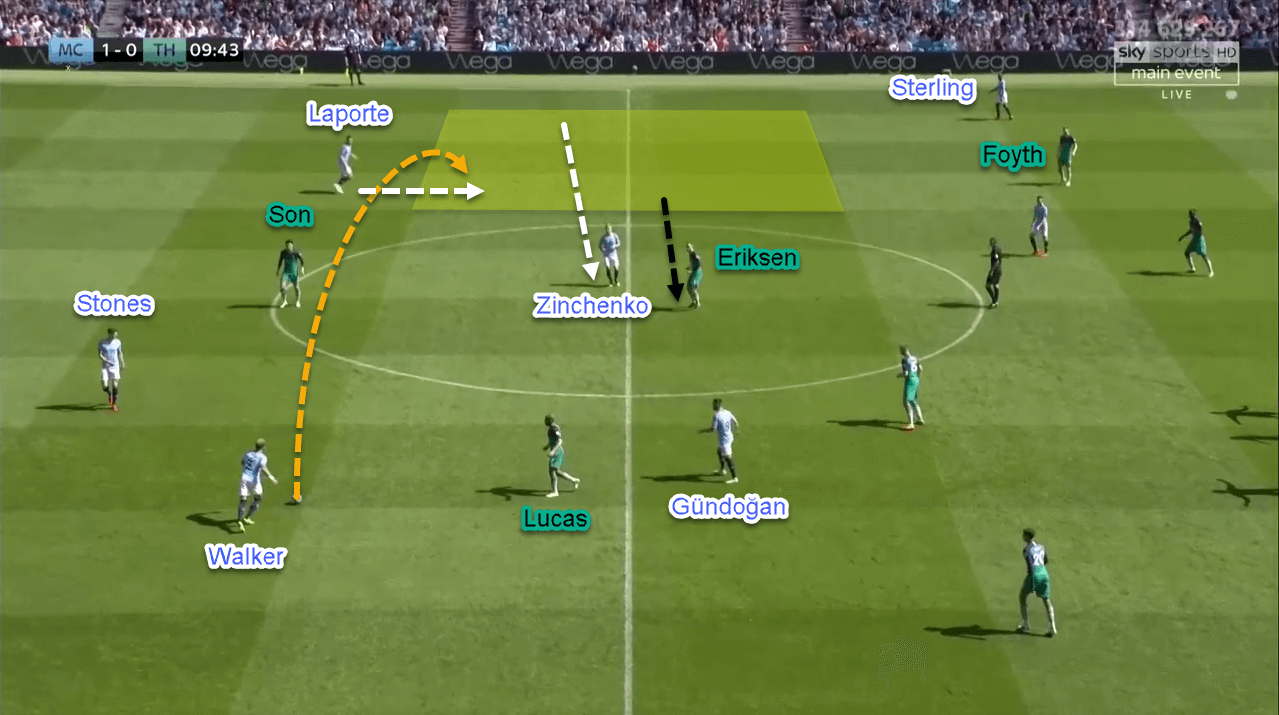
Spurs’ approach
Pochettino and his staff had to find ways to attack City, especially after conceding a quick goal. As they rarely got the ball, Spurs relied heavily on transitional attacks. Their main outlets were Son and Alli, who possess amazing ability to time their runs and also have good dribbling skill.
Their main provider was Eriksen, whose vision and passing competence is one of the best in the world. If Eriksen was shut down, Alderweireld was the alternative. With them, Spurs tried to attack the space between Walker and Stones, as they were arguably the weakest links in City’s defensive department.
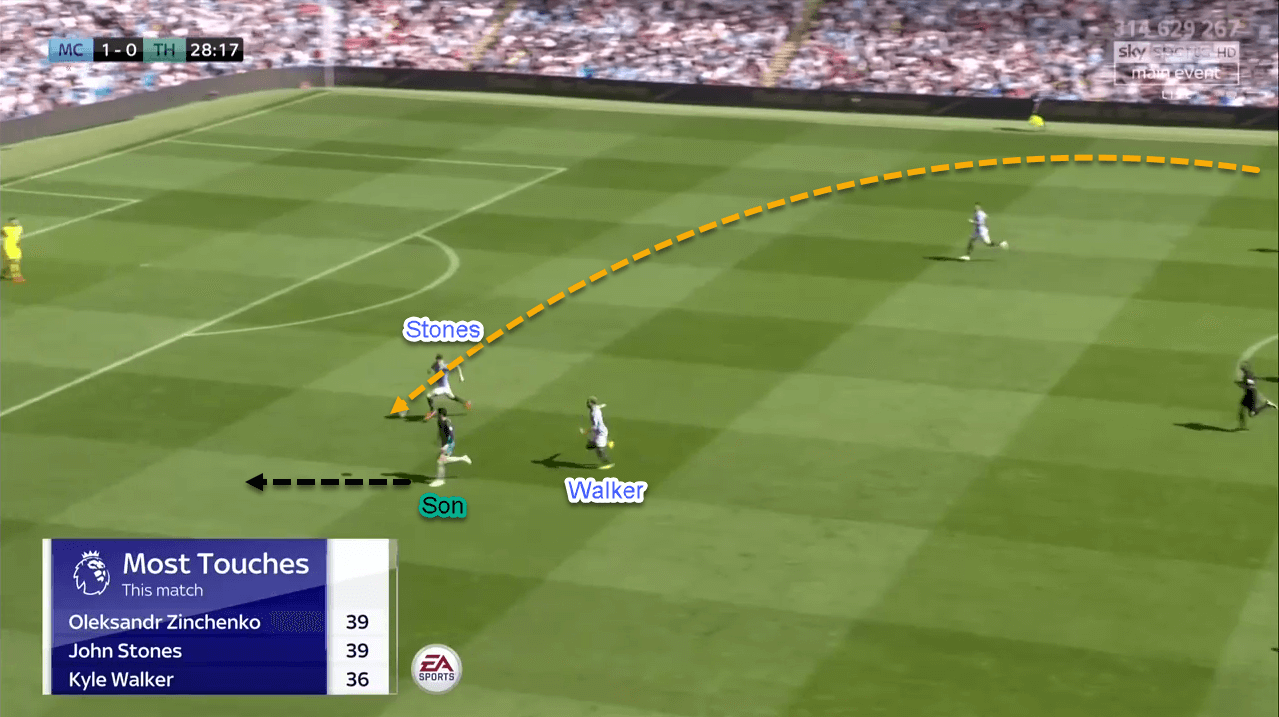
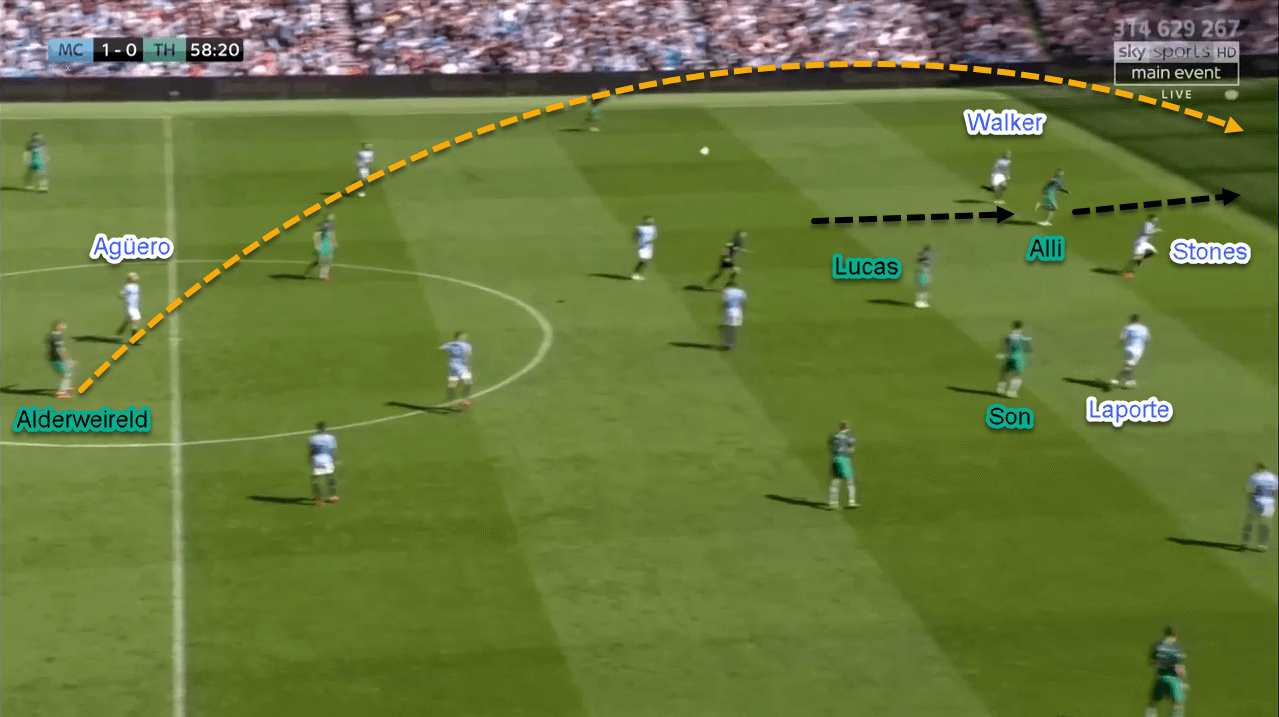
City have defensive issues too
Off the ball, Guardiola set his team up in a 4–2–3–1. This was an interesting yet dangerous approach. In the 4–2–3–1, City got more players in advanced defensive positions, allowing themselves to make transitional attacks more quickly. Somehow, the shape became an issue since there was a space in front of the full-backs as the wingers wouldn’t track back.
Not only that, City’s starting midfielders (De Bruyne and Gündoğan) were not defensive-minded. They didn’t have good defensive awareness nor good one-on-one defending ability. The ball-side full-back then was forced to cover more ground and make them more vulnerable defensively.
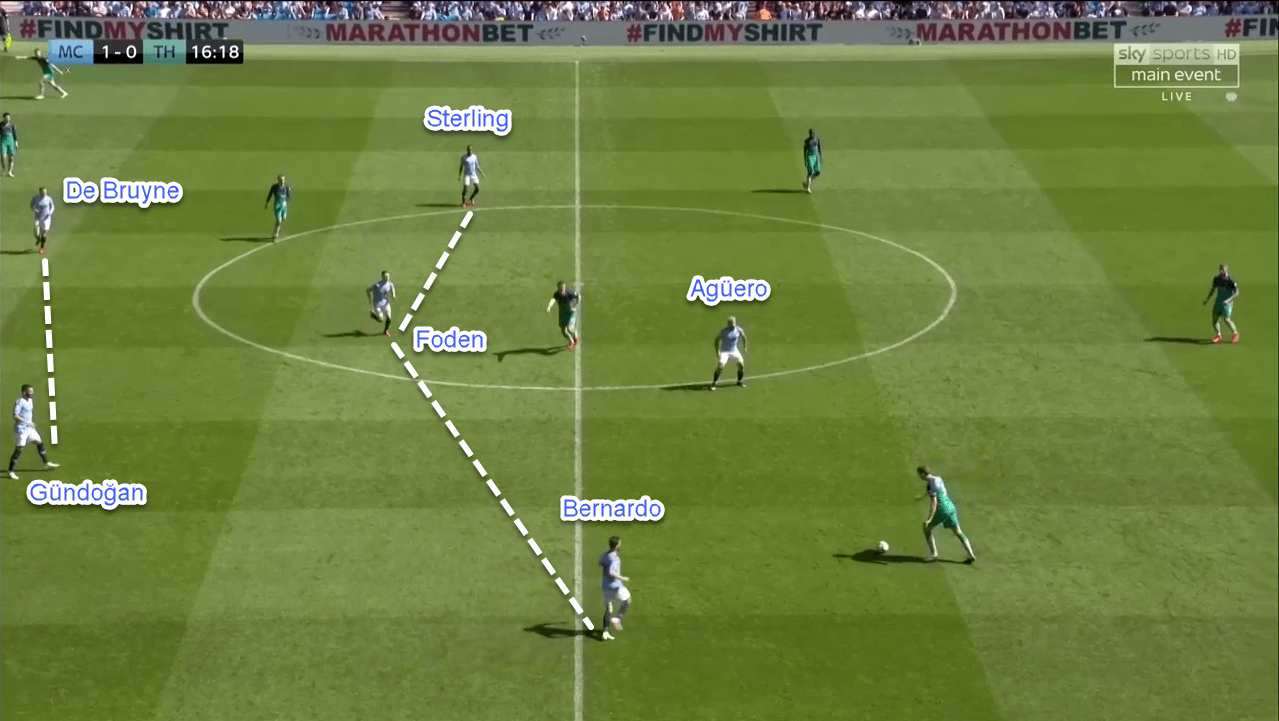
Spurs tried to exploit the issue by putting an attacking player in between City’s ball-side full-back and winger. In that area, he would receive freely and then face the full-back in a one-on-one situation. It didn’t happen often, though.
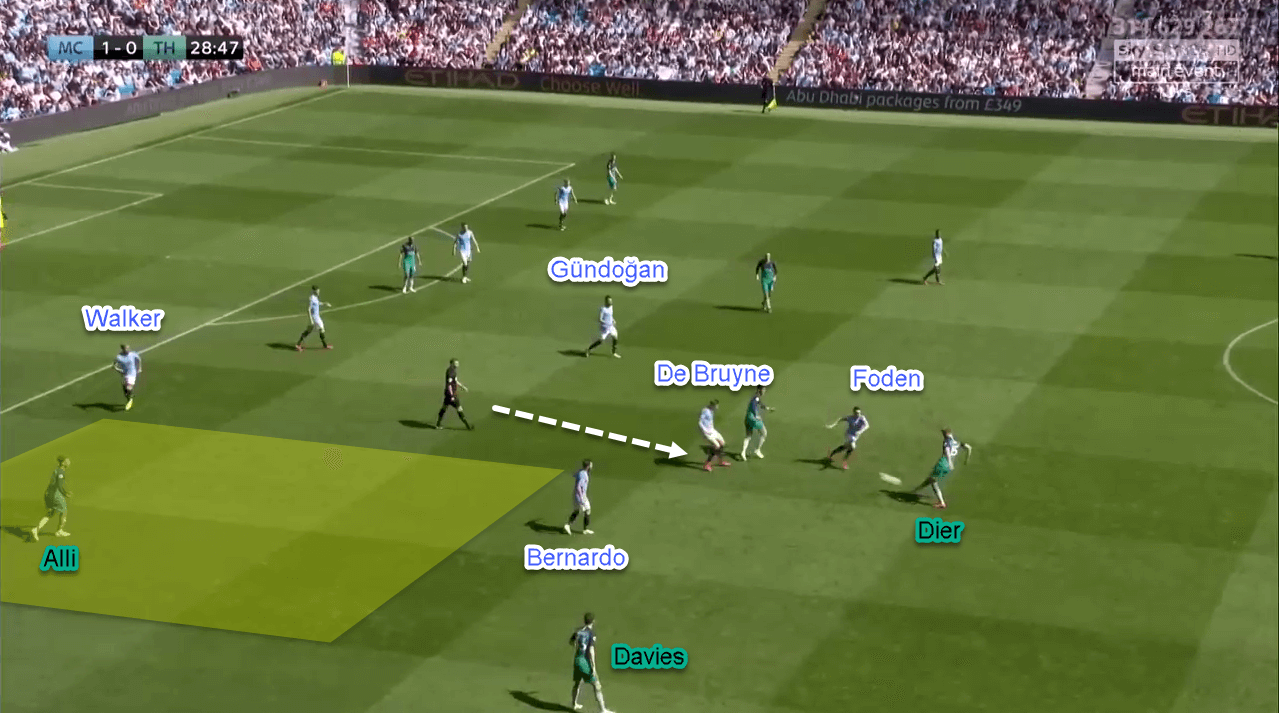
One clever combination from Spurs
In the first half, Spurs did exploit City’s 4–2–3–1 issue once. The ball started on Spurs’ right flank with Foyth as the ball carrier. City’s wingers were positioned inside the half-space. The objective was to prevent Spurs’ centre-backs from building up comfortably.
In this sequence, Foyth receives the ball freely on the right flank. Zinchenko reacted by stepping up from his position to press Foyth. By doing so, Zinchenko opened up space behind him. Lucas then moved up to exploit that vacated area from the next movement. Before we go further, notice Eriksen and Alli, who have already started their runs; especially Alli’s run from De Bruyne’s blind spot.
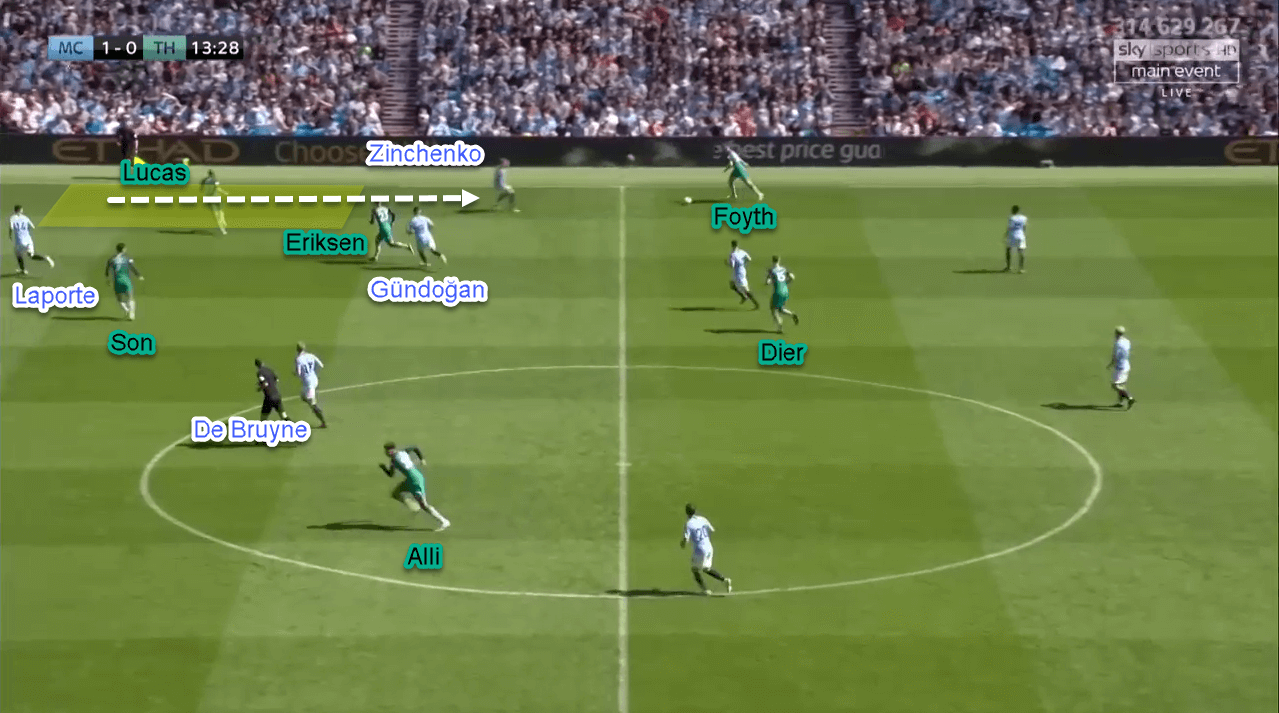
Seeing Gündoğan actively following Eriksen, Son decided to drop. Son’s dropping movement allowed him to be Foyth’s only possible forward pass option.
Son hits three birds with one stone
Firstly, he made Gündoğan confused and eventually made him lose his focus on Eriksen. Secondly, with Eriksen now on the loose that split Laporte’s focus between following Lucas or Eriksen. Thirdly, Son’s movement was followed by Stones, who left a huge space behind him ready to be attacked by the unmarked Alli.
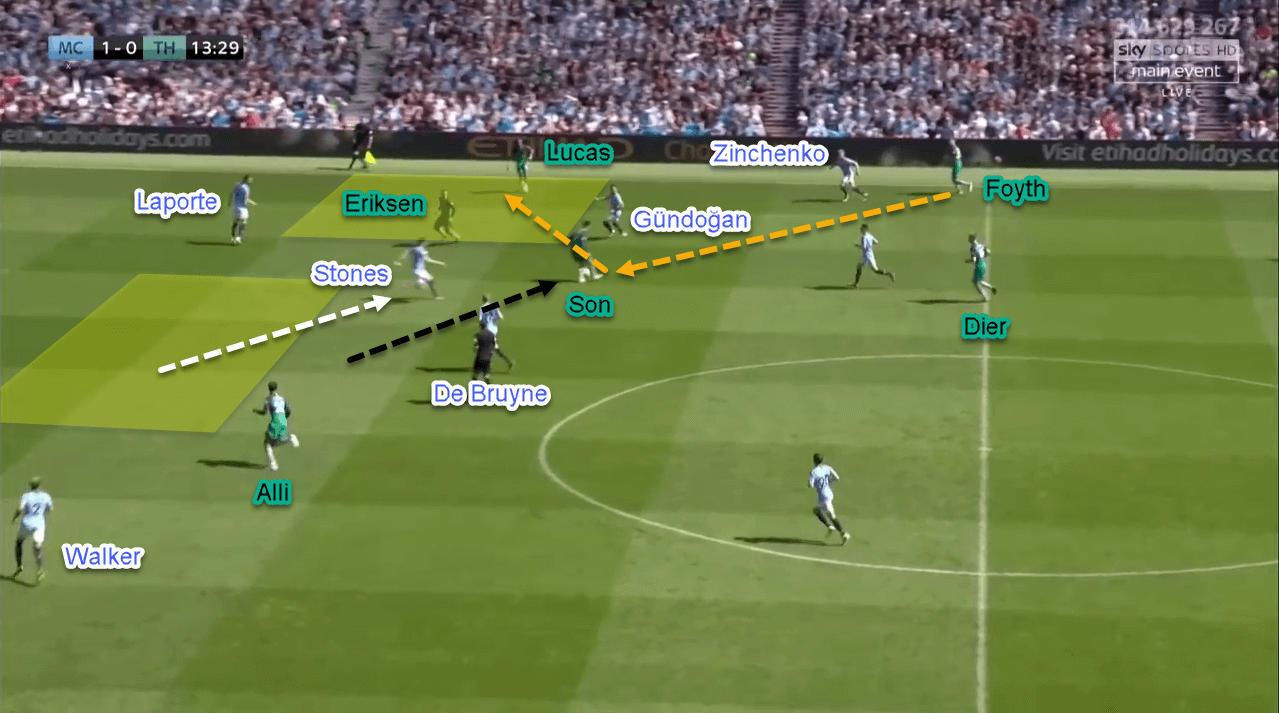
After receiving from Foyth, Son found Lucas with his first touch. Lucas realised that Stones had left a huge gap behind him. Worse for City, Laporte was caught in no man’s land. He had to face two blind-spot runners behind him while also having to anticipate a one-on-one duel against Lucas.
However, City got a little bit lucky in this scenario. Lucas didn’t pick the right option, as his pass only reached Eriksen rather than Alli. Even though Eriksen managed to create a dangerous chance, it was Alli who had more advantage with the space and better shooting angle from his brilliant run. Had Eriksen and Lucas swapped positions in this sequence, the result could have been different.
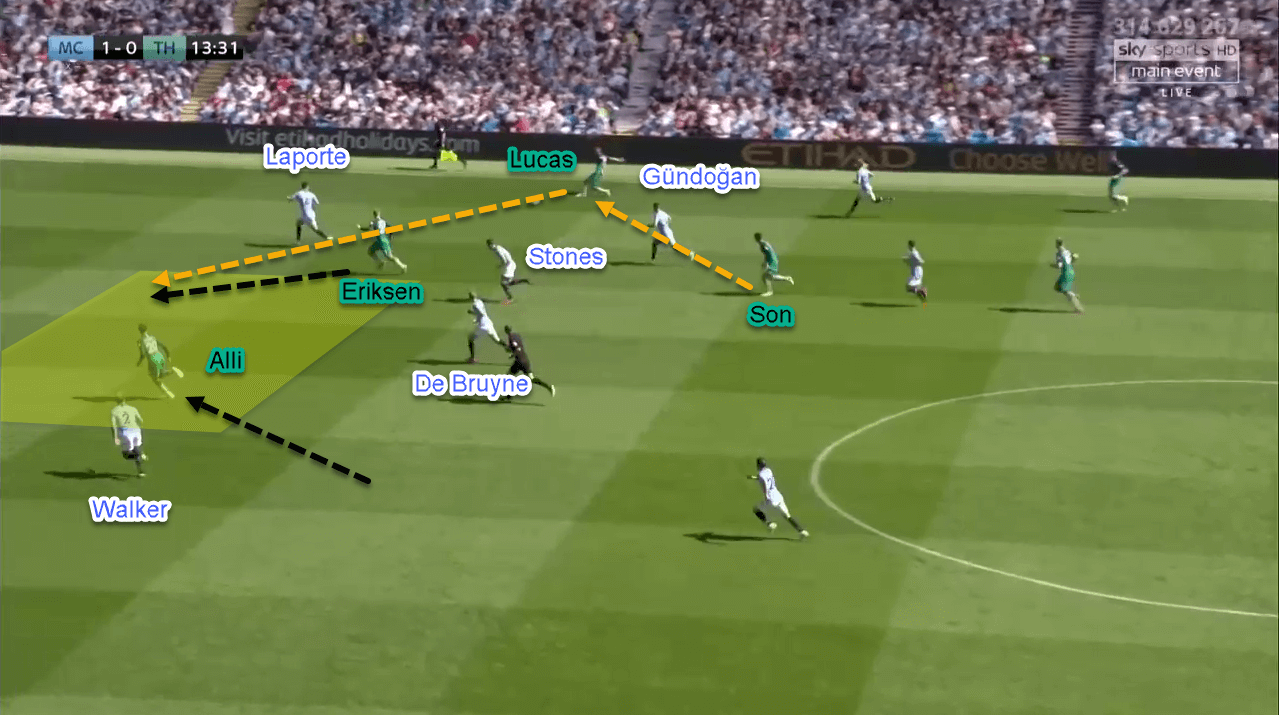
Cautious second half
Guardiola used 4–2–3–1 more often in the second half as City’s preferred attacking shape. This approach provided more defensive solidity as City had two midfielders, Gündoğan and Fernandinho, in deeper areas. Even so, Gündoğan still offered some attacking contributions. He did that not by placing himself high in an advanced area or between the lines, but by carrying the ball into those areas.
City’s cautious approach was more visible especially after Agüero was subbed off. The four attackers would sometimes drop at the same time and none of them made runs in behind. This was evident because of the lack of exploitation of the space behind Sánchez, which happened quite often in the opening half.
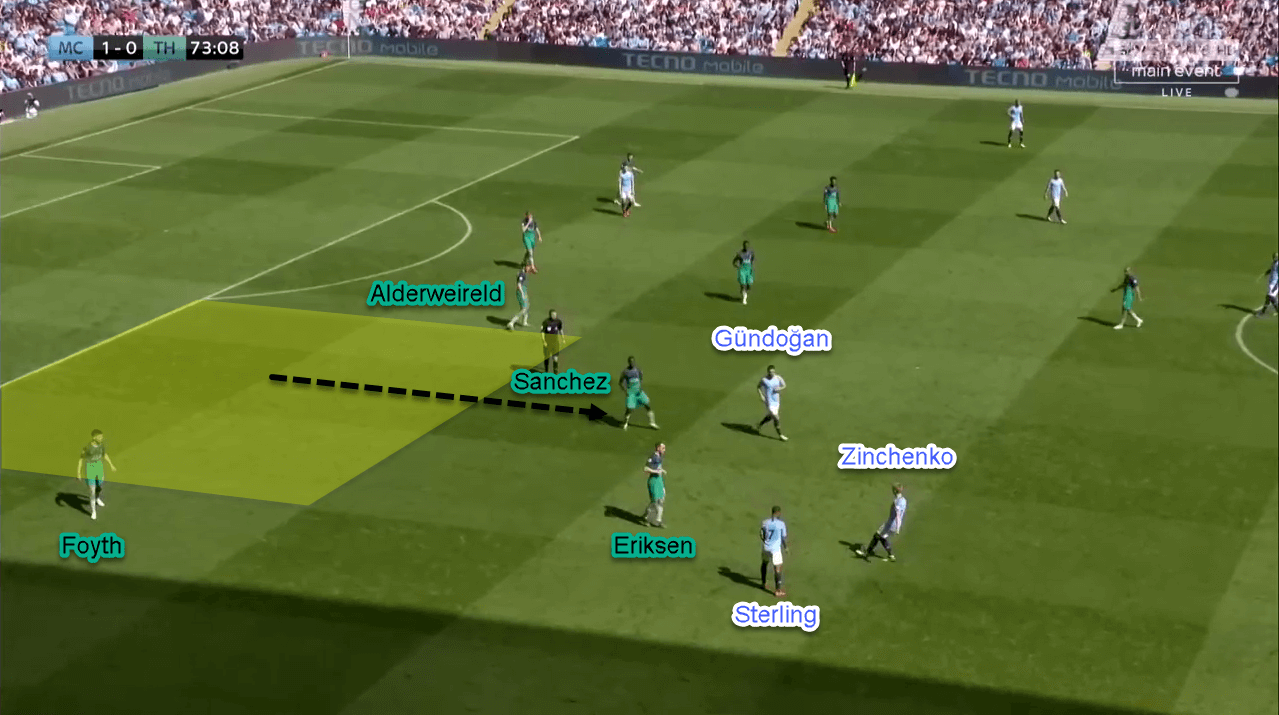
Meanwhile, on the opposite side, Pochettino realised that his 5–3–2 was flawed. One reason was the shape would open a huge space between the lines, especially if City successfully escaped Spurs’ high press. Pochettino then sent Wanyama on for Dier after the hour mark.
Another reason was continuous drives by Walker inside the right-side half-space. Pochettino adjusted to this by pulling Alli off for Rose. Spurs then changed their shape into a 5–4–1 with Rose as a left winger. By putting Rose in that place, Spurs effectively stopped Walker from making his driving runs.
Not only that, but Pochettino also pulled Lucas back in the process and told him to join the midfield line. Another interesting adjustment was Son given almost no defensive duties for most of the second half. The reason was to allow the Korean to reserve his energy and focus more on the transitional attacks.
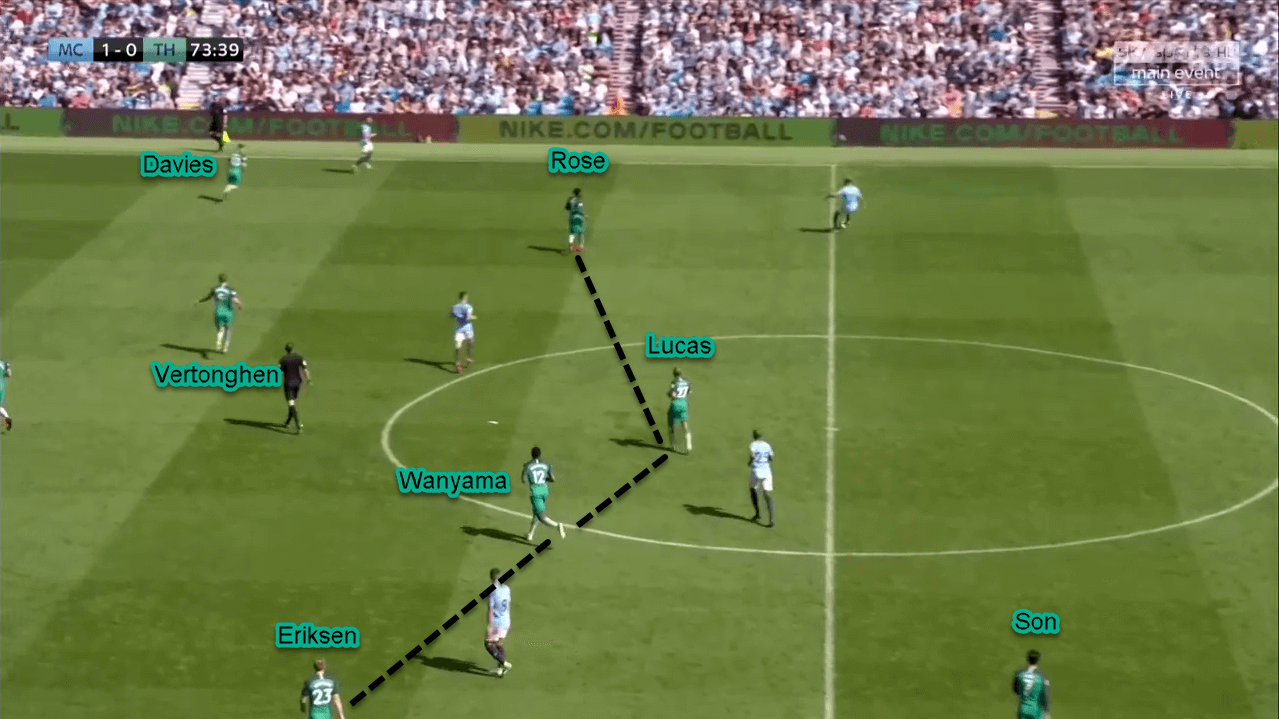
Conclusion
City and Spurs came into this match with depleted squads and exhaustion after the midweek clash, yet this game still served a great tactical battle between Guardiola and Pochettino. Both teams had their chances but it was Foden’s header that proved to be the difference.
With this important win, City got the result they desperately needed, thus continuing their title race against Liverpool. However, they suffered a major blow after De Bruyne went out injured in the first half. Now, Guardiola and his staff have to think even harder and use every resource available for the remaining four games. Can they hang on?
Let’s see.
If you love tactical analysis, then you’ll love the digital magazines from totalfootballanalysis.com – a guaranteed 100+ pages of pure tactical analysis covering topics from the Premier League, Serie A, La Liga, Bundesliga and many, many more. Buy your copy of the April issue for just ₤4.99 here, or even better sign up for a ₤50 annual membership (12 monthly issues plus the annual review) right here.

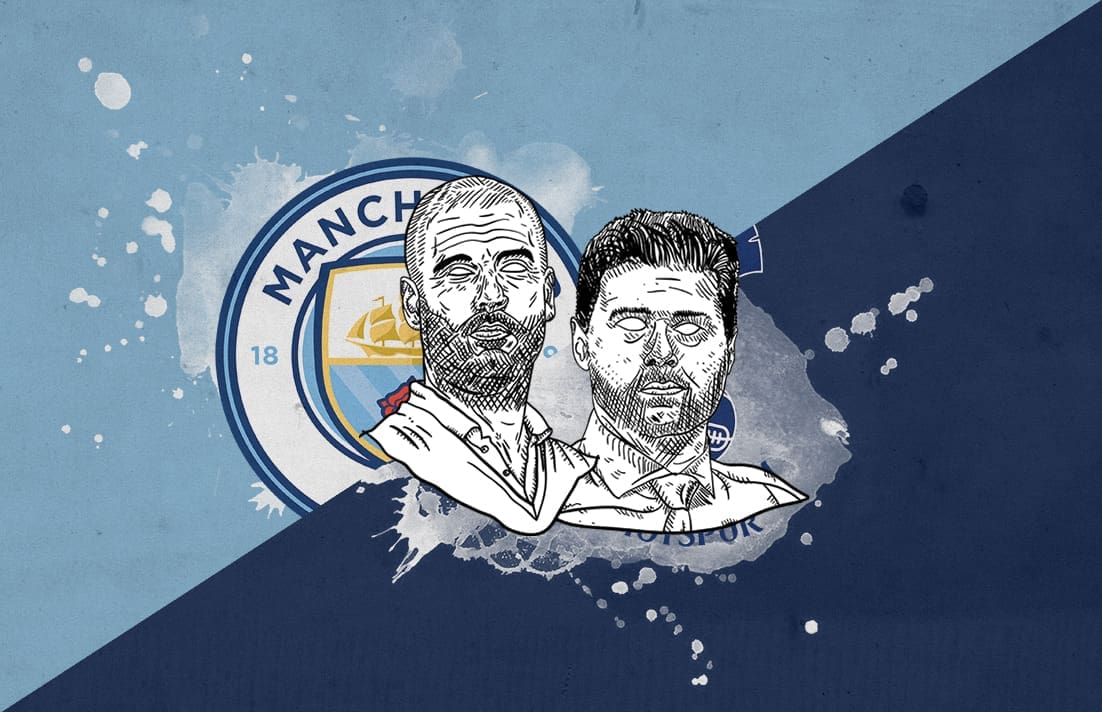



Comments